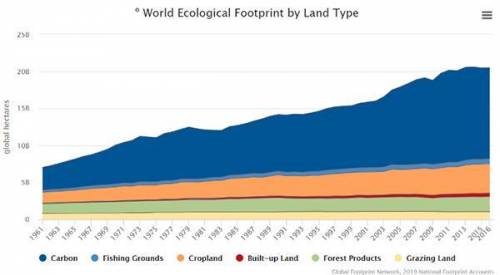
Biology, 23.11.2020 23:10, shaheedbrown06
An increase in consumption of resources may result in a scarcity of critical resources, including food, land, water, and fuel. This increase in resource use may also be accompanied by degradation of resources.
Review the graph below:
Line graphs showing the world ecological footprint by land type of carbon, fishing grounds, cropland, built up land, forest products, and grazing land measured in global hectares from 1961 to 2016. The graphs sections are layered on top of each other to show the cumulative amount. In 1961, the total was 7.05 billion global hectares, which increased to 20.5 billion global hectares in 2016. From 1961 to 2016, the increase in global hectares were 81 million to 473 million for built up land, 3.09 billion to 12.3 billion for carbon, 1.44 million to 3.98 million for cropland, 294 million to 670 million for fishing grounds, 1.32 billion to 2.04 billion for forest products, and 816 million to 1.05 billion in grazing lands.
© 2020 Global Footprint Network
A.
i. Explain the variables that make up the ecological footprint of an individual or country.
ii. Identify the component that is the largest contributor to the world's ecological footprint. Explain reasons for its current graphical trend.
B. The goal of sustainability is to stop and possibly undo some of the damage done to Earth's systems by using restorative processes and following a sustainable yield model when harvesting resources.
i. Describe an example of resource harvesting that uses a sustainable yield model.
ii. Propose one restorative process that reduces human impact on forest resources. Justify your proposed solution.


Answers: 3
Other questions on the subject: Biology

Biology, 22.06.2019 06:50, Shaylaharrison15
The kidney filters potentially toxic substances in the blood, and thus “clears” the blood of those substances. this clearance function is dependent upon and proportional to the diffusion gradient of the substance across filtering capillaries, i. e. if the concentration of the substance is doubled, twice as much will be cleared from each ml of blood that is filtered. suppose that the body produces a constant amount of a substance x per unit of time. the kidneys eliminate substance x at a rate directly proportional to the concentration of the substance and the volume of blood cleared each minute (c): elimination = c × [x], where [x] is the steady-state concentration of substance x. imagine an individual with an initial concentration of x equal to [x]0 who develops kidney disease. her baseline clearance c0 drops to one half of the original (½c0). what is the new steady state concentration of x? (for simplicity, assume that substance x is 100% filtered by the kidney).
Answers: 1

Biology, 22.06.2019 07:50, andrewmena05
How are fungi more like an animal? they have a cell wall. they are heterotrophs that absorb their food. they produce seeds and have membrane-bound nucleus. they use sunlight for photosynthesis.
Answers: 1


Biology, 23.06.2019 01:00, Jazminfun70
30 points! explain the 3 differences in the chart below: flowers cones spores 1. 1. 1. 2. 2. 2. 3. 3. 3. i am not sure what the differences between them are, if someone could explain that would be
Answers: 1
Do you know the correct answer?
An increase in consumption of resources may result in a scarcity of critical resources, including fo...
Questions in other subjects:

Spanish, 25.08.2021 23:50


Mathematics, 25.08.2021 23:50



Mathematics, 25.08.2021 23:50

Spanish, 25.08.2021 23:50

Mathematics, 25.08.2021 23:50








